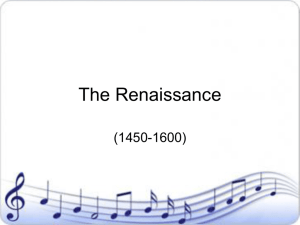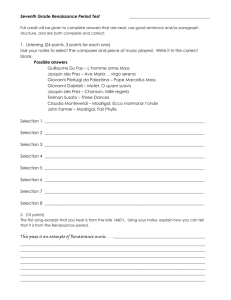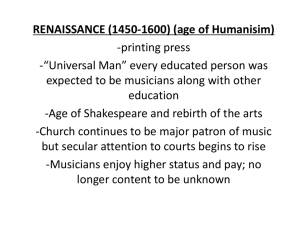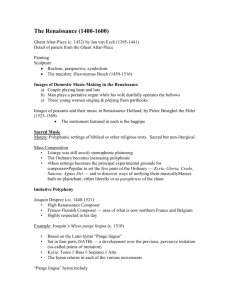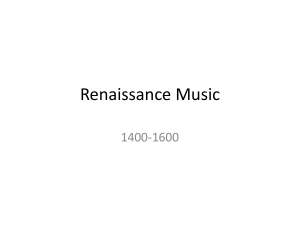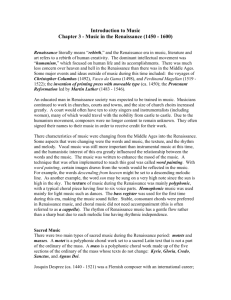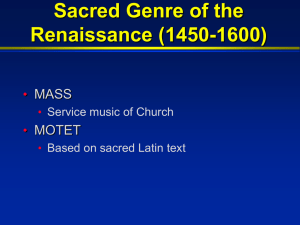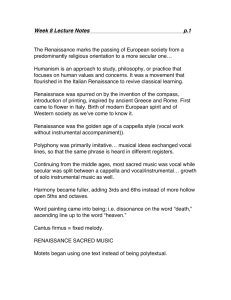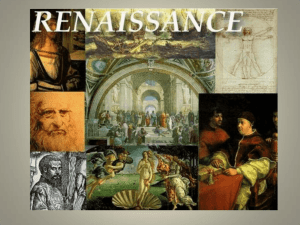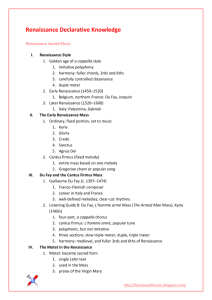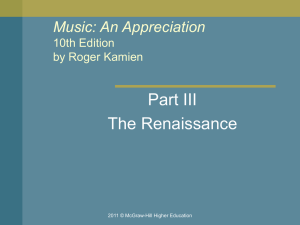Renaissance Music History Questions - Unit III
advertisement
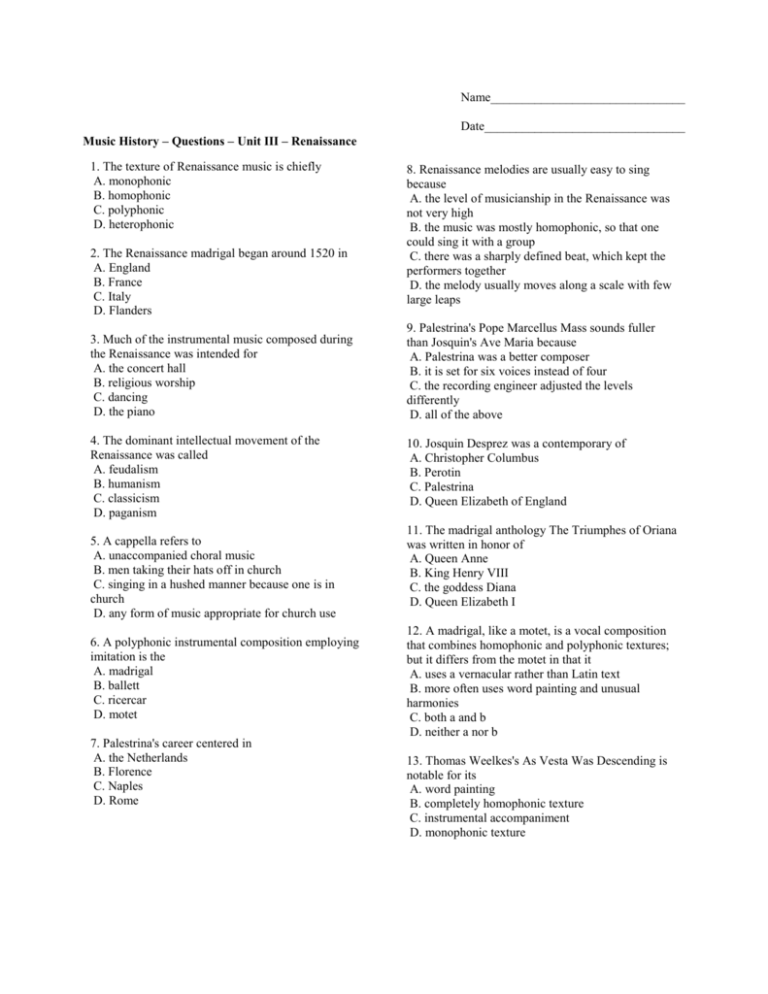
Name_______________________________ Date________________________________ Music History – Questions – Unit III – Renaissance 1. The texture of Renaissance music is chiefly A. monophonic B. homophonic C. polyphonic D. heterophonic 2. The Renaissance madrigal began around 1520 in A. England B. France C. Italy D. Flanders 8. Renaissance melodies are usually easy to sing because A. the level of musicianship in the Renaissance was not very high B. the music was mostly homophonic, so that one could sing it with a group C. there was a sharply defined beat, which kept the performers together D. the melody usually moves along a scale with few large leaps 3. Much of the instrumental music composed during the Renaissance was intended for A. the concert hall B. religious worship C. dancing D. the piano 9. Palestrina's Pope Marcellus Mass sounds fuller than Josquin's Ave Maria because A. Palestrina was a better composer B. it is set for six voices instead of four C. the recording engineer adjusted the levels differently D. all of the above 4. The dominant intellectual movement of the Renaissance was called A. feudalism B. humanism C. classicism D. paganism 10. Josquin Desprez was a contemporary of A. Christopher Columbus B. Perotin C. Palestrina D. Queen Elizabeth of England 5. A cappella refers to A. unaccompanied choral music B. men taking their hats off in church C. singing in a hushed manner because one is in church D. any form of music appropriate for church use 6. A polyphonic instrumental composition employing imitation is the A. madrigal B. ballett C. ricercar D. motet 7. Palestrina's career centered in A. the Netherlands B. Florence C. Naples D. Rome 11. The madrigal anthology The Triumphes of Oriana was written in honor of A. Queen Anne B. King Henry VIII C. the goddess Diana D. Queen Elizabeth I 12. A madrigal, like a motet, is a vocal composition that combines homophonic and polyphonic textures; but it differs from the motet in that it A. uses a vernacular rather than Latin text B. more often uses word painting and unusual harmonies C. both a and b D. neither a nor b 13. Thomas Weelkes's As Vesta Was Descending is notable for its A. word painting B. completely homophonic texture C. instrumental accompaniment D. monophonic texture 14. The development of the English madrigal can be traced to 1588 and considered a result of A. the Spanish armada B. a decree by Queen Elizabeth C. the writings of Shakespeare D. the publication in London of a volume of translated Italian madrigals 15. Which of the following statements is not true? A. Josquin's compositions strongly influenced other composers, and were praised enthusiastically by music lovers. B. Josquin spent most of his life in the province of Hainaut, today a part of Belgium. C. Josquin's compositions include masses, motets, and secular vocal pieces. D. Josquin's Ave Maria . . . Virgo serena uses polyphonic imitation, a technique typical of the period. 16. An attempt was made to purify Catholic church music as a result of the A. music of Palestrina B. deliberations of the Council of Trent C. complaints of Desiderius Erasmus D. founding of the Jesuit order in 1540 17. A versatile plucked string instrument with a body shaped like half a pear, popular during the Renaissance, was the A. lute B. recorder C. viol D. shawm 18. Which of the following is not a characteristic of the Renaissance ballett? A. a dancelike song for several voices B. mostly polyphonic texture C. the syllables fa-la used as a refrain D. repetition of the same music for each stanza of the poem 19. The _____________ is a stately dance in duple meter similar to the pavanne. A. galliard B. passamezzo C. saltarello D. minuet 20. During the Renaissance every educated person was expected to A. play an instrument B. dance C. read notation D. all of the above 21. The focal point of music in Venice was A. the Tivoli Gardens B. the Venetian school C. the Villa d'Este D. St. Mark's Cathedral 22. A polychoral motet is a A. polyphonic composition for mixed voices B. motet for two or more choirs, often including groups of instruments C. homophonic composition for brass choir D. five-voiced choral composition 23. Unlike most Renaissance choral music, Venetian choral music of the late sixteenth century often A. used both male and female voices B. was scored for four to six voices C. contained parts written exclusively for instruments D. was predominantly in triple meter 24. Which of the following is not true of Venice in the sixteenth century? A. It was a part of the Papal States on the northeastern coast of Italy. B. It was a seaport built on tiny islands separated by canals. C. It became a center of instrumental and vocal music. D. It was a thriving commercial center for trade between Europe and the near east. 25. St. Mark's Cathedral in Venice was noted for its A. underground treasuries B. two widely separated choir lofts C. regressive attitude toward contemporary music D. use of musicians performing in gondolas 26. Giovanni Gabrieli A. was the most important Venetian composer of the late Renaissance B. was an organist at St. Mark's Cathedral from 1585 until his death in 1612 C. studied music with his uncle, Andrea Gabrieli D. all of the above
